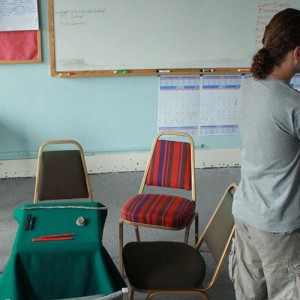
39 minutes and 52 seconds.
1. Technique “Full”/”Law of Two Feet”
2. Technique “the Meadow”
- A modification of technique “Pooh Corner”, developed for the SYL conference.
- A place for “full” lunatic-fringers to go to recuperate.
- Inspired by Open Space Technology gatherings.
- The Meadow is liberally sprinkled with interesting and topically relevant books and materials to look at while recuperating.
- People in the Meadow can still see the game, but have conversations quietly without disturbing the game.
3. Technique “Culture of Interaction”
- Willem put up posters around the room bearing key WAYK techniques, like “how fascinating!’, “we’ll all get there together”, “bite-sized pieces”, and more.
4. Technique “Nip it in the Bud”
- There are certain objections or concerns we want to address, before people even bring them up, at the beginning of a workshop or game experience.
5. Technique “That sounds like it would work for other people, but it would never work for me…”
- We address this objection by, as much as possible, applying WAYK as soon as possible to players’ specific language challenges.
6. Technique “Sad Clowns”
- Sometimes people have a hard time taking us, and WAYK, as a serious applied pedagogical science, because of the silly, high-energy nature of WAYK.
- The difference between effective education, and entertainment, is a fine line.
- We address this issue as soon as possible, by talking about the scientific backing of many of the techniques. The rest are waiting for Ph.D. candidates to investigate why they work!
7. Techniques “Comedy Duo”, “It’s Science!”/”Scientifically Proven!”
- Usually, at the beginning of a workshop, Evan and Willem banter back and forth to set the fun tone of the game experience.
- For the next workshop, Evan plans to preface this joking by introducing the material with a very serious, professional run down of the pedagogical science we’re applying to language.
8. Technique “Play First, Puzzle Later”/”Many Eyes on the Problem”
- Evan and Willem plan to add a section to the end of the workshop, dedicated to applying WAYK to specific language conundrums.
- If a participant doesn’t play, we are limited in how much we can help them later.
- At the end of the workshop, a room full of trained WAYK players can then apply their new skills to the specific participant’s language challenge.
9. Technique “WAYK Workshop”
- We use 4 fundamental group activities at the workshop.
10. Technique “the Lotus”
- The core group WAYK conversation set-up.
11. Technique “Pairing”
- We include pairing because if we don’t have people play in pairs, they likely won’t do it outside the workshop. Whatever we want folks to do later, we have them do now (“you go first”/”modeling”).
12. Technique “Tea with Grandma”
- Role playing the language hunt of grandma’s language.
- Before you can play Tea with Grandma, you must have the following WAYK skills: “What is that?”, “Is that a…?” (Make me say yes…, Make me say no…), “Mine/yours”, “want/have/give/take”, “CL: for, if, then, and, but…”
- Getting to the “CL: for, if then, and but…” usually indicates players finally understand the acceleration of adding richness to language, rather than adding topics/nouns.
- Questions CL: “What?”,”Who/whose?”, “Where?”.
- Locative CL: Above, below, in front, behind, next to…
13. Technique “Speed Dating”
- Rotating through pairing with fluent speakers of various, random languages, to practice the one-minute language hunt. This occurs in parallel to a lotus table of WAYK players in the corner, which usually results in a group language hunt there.
14. Technique “Many Eyes on the Problem”
- For the fifth group activity, that we will add to the next workshop, we will create a “what is that/make me say yes/make me say no” curriculum, as a group, for their language.
15. Technique “Último”
- If you create your WAYK play community well, you will never have to play “what is that?” with a newbie again, after teaching the first one.





How will you fit the additional activity of developing a What’s That? curriculum for a language? I was pretty worn out at the end of two days. Is there something else you’ll remove? Or are you counting on things getting faster?
Evan and I actually sat down with David and did this with him at the end, so maybe I did have enough energy. 🙂
Evan mentioned Technique “Lug Wrench” and then didn’t get a chance to describe it. I’ll take a stab at it, for the benefit of other readers.
If your target language has an associated sign language, should you use ASL/PSE, or should you use the target’s sign language?
You should use the target’s sign language if you can. Each culture has its own way of seeing the world, which is reflected in the language. Having that common view reflected in both the sign and spoken languages makes it easier to do WAYK.
However, if you don’t have an associated sign language, then use ASL/PSE, because it’s what you’ve got.
When removing a wheel from a car, the best lug wrench is the one that comes with the car, but if you don’t have that, a generic lug wrench will do.
Technique: Lug Wrench
Great description, Jay. Exactly – the best lug wrench is the one that comes from the car. The best sign language is the one already a part of the culture.
This applies to keys as well – they fit the keyhole less well each time a copy is made of the original and then a copy is made of the copy, etc-etc. 😀